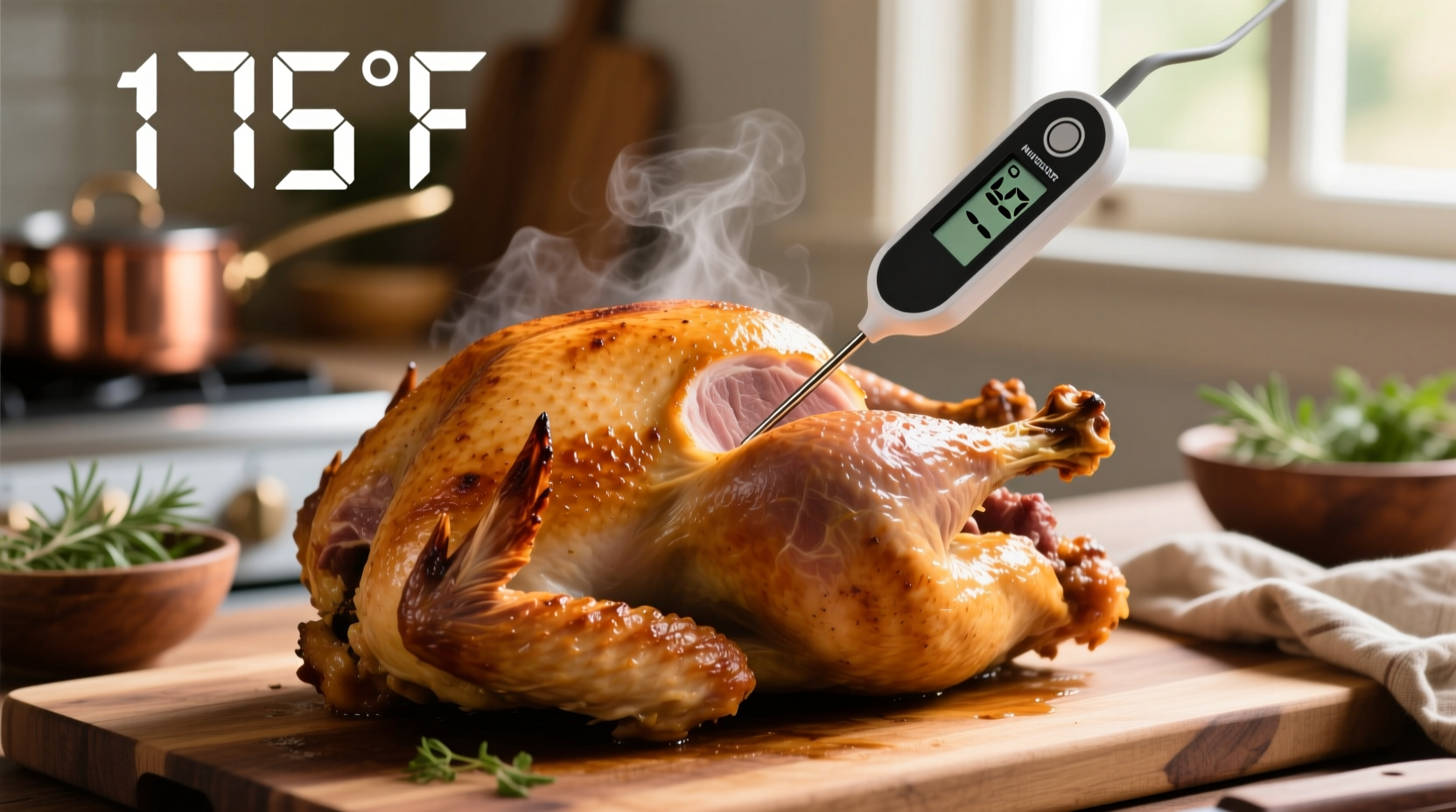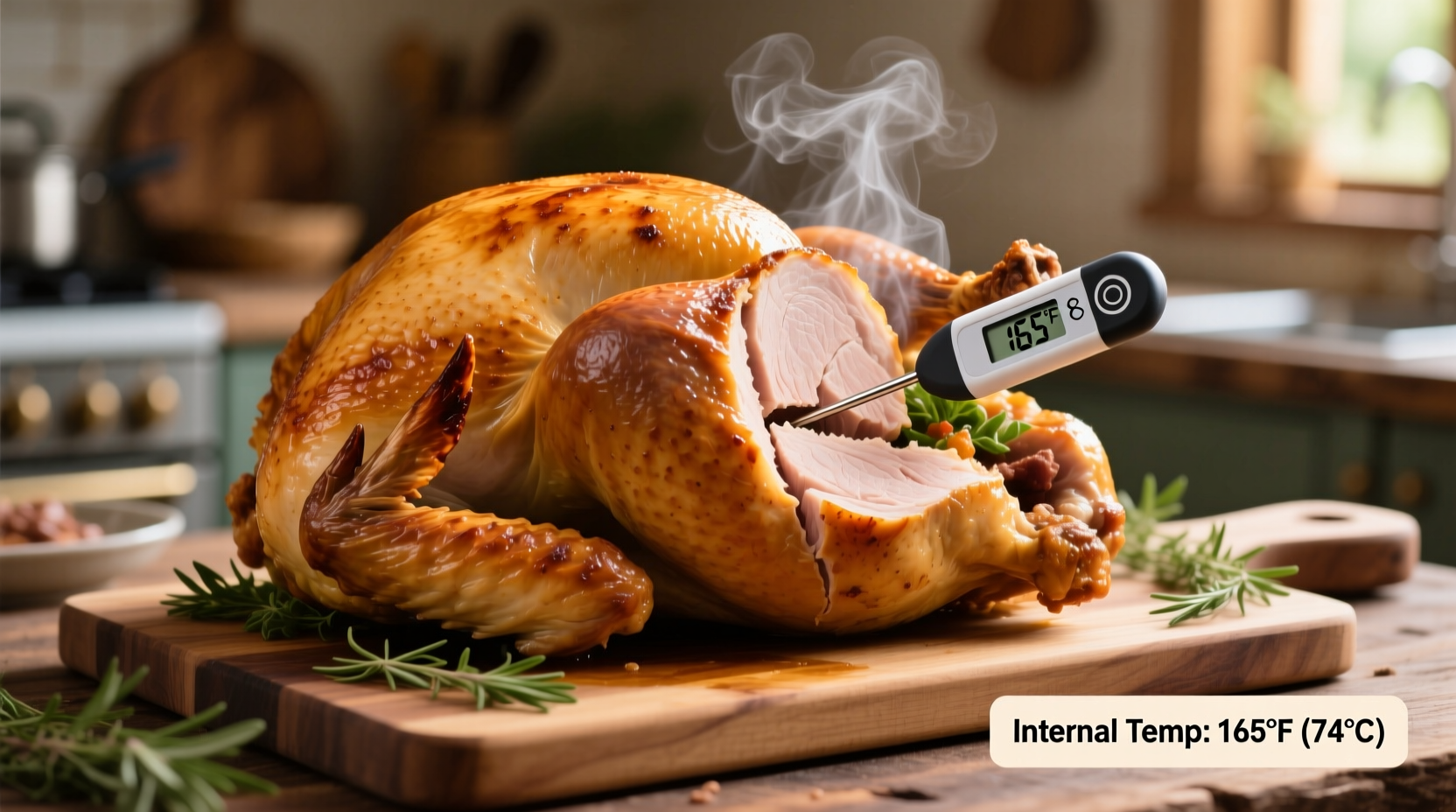Why 165°F Is Your Turkey's Safety Threshold
When you're preparing turkey for your holiday meal or Sunday dinner, getting the temperature right isn't just about perfect texture—it's a critical food safety requirement. The USDA Food Safety and Inspection Service has established 165°F as the minimum safe internal temperature for all poultry products, including whole turkeys, turkey breasts, and ground turkey.
At this precise temperature, dangerous pathogens like Salmonella and Camphylobacter that commonly contaminate raw poultry are completely destroyed. Lower temperatures simply don't eliminate these risks. According to research from the USDA Food Safety and Inspection Service, even a few degrees below 165°F leaves some bacteria viable.
Measuring Temperature Correctly: The Professional Approach
Simply knowing the target temperature isn't enough—you must measure it properly. Here's how professional chefs ensure accuracy:
- Use a reliable instant-read thermometer - Digital thermometers provide the most accurate readings in 3-5 seconds
- Check multiple locations - Measure in the innermost part of the thigh, wing, and thickest part of the breast
- Avoid bone contact - Place the probe in meaty areas, not touching bone which conducts heat differently
- Verify before removing from heat - Check temperature 10-15 minutes before expected finish time
| Part of Turkey | Target Temperature | Measurement Location |
|---|---|---|
| Thigh | 165°F (73.9°C) | Innermost part, not touching bone |
| Wing joint | 165°F (73.9°C) | Thickest area near body |
| Breast | 165°F (73.9°C) | Thickest part, away from bone |
| Stuffing | 165°F (73.9°C) | Center of stuffing mass |
Common Temperature Mistakes That Risk Food Safety
Many home cooks make critical errors when checking turkey temperature:
- Trusting pop-up thermometers - These often trigger between 160-170°F and aren't reliable indicators of safety
- Measuring too early - Checking temperature before the turkey has finished cooking causes heat loss
- Single-point measurement - Only checking one location misses cold spots where bacteria survive
- Not calibrating thermometers - Uncalibrated thermometers can be off by 5-10 degrees

Carryover Cooking: Why Temperature Continues Rising
Understanding carryover cooking is essential for perfect results. When you remove turkey from the oven, the internal temperature continues to rise 5-10 degrees during resting. This happens because heat from the outer layers transfers to the center.
For best results, remove your turkey from the oven when it reaches 160-162°F, then let it rest for 20-30 minutes before carving. During this time, the temperature will reach the safe 165°F threshold while the meat reabsorbs juices for optimal texture.
Special Considerations for Different Turkey Preparations
Certain cooking methods require additional temperature considerations:
- Smoked turkey - Maintain smoker temperature between 225-250°F and verify internal temperature reaches 165°F
- Sous vide turkey - Cook at 145°F for 2+ hours for pasteurization, though texture differs from traditional methods
- Deep-fried turkey - Oil temperature should be 350°F, but internal meat must still reach 165°F
- Stuffed turkey - Both turkey and stuffing must reach 165°F; consider cooking stuffing separately for safety
Food Safety Timeline: From Raw to Safe Consumption
Understanding the complete food safety timeline helps prevent illness:
- Thawing - Never thaw at room temperature; use refrigerator (allow 24 hours per 4-5 pounds), cold water (30 minutes per pound), or microwave
- Preparation - Keep raw turkey separate from other foods; sanitize surfaces that contact raw poultry
- Cooking - Ensure all parts reach minimum 165°F internal temperature
- Resting - Let turkey rest 20-30 minutes before carving to allow temperature to stabilize
- Serving - Keep hot foods above 140°F; don't leave turkey at room temperature more than 2 hours
- Leftovers - Refrigerate within 2 hours; consume within 3-4 days or freeze
Temperature Verification: Best Practices for Home Cooks
Follow these steps for guaranteed safe turkey every time:
- Insert thermometer into thickest part of breast, avoiding bone
- Check temperature 10-15 minutes before expected finish time
- Verify all critical areas (thigh, wing joint, breast) have reached 165°F
- For stuffed turkey, check both meat and stuffing temperatures separately
- If below 165°F, return to oven and recheck every 5-10 minutes
- Allow proper resting time before carving
Remember that color is not a reliable indicator of doneness—turkey can appear pink even when properly cooked to 165°F due to myoglobin reactions. Only a food thermometer provides definitive safety verification.











 浙公网安备
33010002000092号
浙公网安备
33010002000092号 浙B2-20120091-4
浙B2-20120091-4